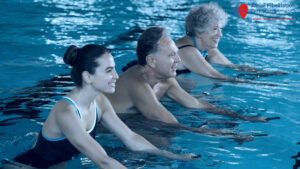While most forms of exercise are beneficial to cardiac health and protective against AFIB. It is to be noted that mild- or moderate-intensity exercise is typically observed to be protective but on the other side; intense exercise typically carries a higher risk of atrial fibrillation.
 It is really important to understand the relationship curve between exercises and Afib which clearly shows that the more you exercise, the lower your risk of Afib — up to a point. But if you exercise more than a certain amount, your risk rises.
It is really important to understand the relationship curve between exercises and Afib which clearly shows that the more you exercise, the lower your risk of Afib — up to a point. But if you exercise more than a certain amount, your risk rises.
It is advised for people with atrial fibrillation not to push themselves too hard when they exercise and to be within their limits.
Swimming Routine with Atrial Fibrillation
Apart from following a routine with normal walking and bicycle exercises, Doctors suggest swimming can also be considered a wise option if done in moderation and not at a competitive level.
However, there is an association between high-intensity exercise over time and the diagnosis of atrial fibrillation. Long-term, competitive swimmers had a prevalence of atrial fibrillation exceeding a comparison group with a significantly higher burden of known cardiovascular risk factors, including diabetes mellitus and hypertension.
However It is important to discuss it with your doctor before you start swimming again. One needs to be considerate and careful enough to notice or realize certain symptoms he/she is facing while swimming like if you find yourself out of breath or feel like you’re otherwise struggling, it’s important to get out of the pool and sit down for a while.
Lets Understand This On a More Deeper Level.
Our heart has to work much harder in the water compared with when we are out of the water because changes to our circulation mean more blood is returning to the heart. When one starts exercising, the heart has to work even harder due to the resistance of the water.
So, for such cases;
You Should Only Swim With a Heart Condition:-
- When you are feeling generally well. It is better to allow at least one hour after a meal to pass before you get in the pool.
- When the water in the pool is between 26–33C (79–91F) as this will have the least effect on your heart. Pools that are hotter than 33C may cause your blood pressure to drop, making you lightheaded or faint. Being in colder water may provoke irregular heart rhythms.
- Avoid swimming under water or with your face in the water for too long as you shouldn’t hold your breath when exercising, this can cause an increased strain on your heart.
- Start and finish your swim at a slower pace.
- You should always stop swimming if you experience chest pain, palpitation, light-headedness or don’t feel well.
Seek medical advice immediately if you start feeling any of the above mentioned symptoms. Atrial Fibrillation Specialist
Conclusion:
It is just the intensity of the exercise that matters and a person who has atrial fibrillation should be a little more careful while performing any of the exercises, not just swimming. As per research, a person can swim with afib however he/she should do it at a low pace and be conscious in noticing symptoms if any.
At Atrial Fibrillation Centers of America, Dr. Shanti Bansal – board certified in Internal Medicine (2010), Nuclear Cardiology (2011), Cardiology (2011), and Electrophysiology (2013), and the team makes sure to deal with all aspects of your cardio needs. You can consult us at (832) 478-5067 or give us a visit in Houston, TX.
